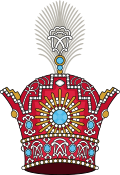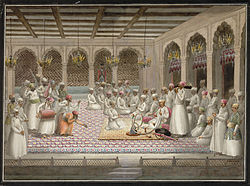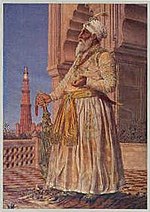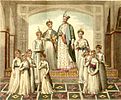Nawab
This article includes a list of generalreferences,butit lacks sufficient correspondinginline citations.(September 2010) |
| Part ofa serieson |
| Imperial, royal, noble, gentry and chivalric ranksinWest,Central,South AsiaandNorth Africa |
|---|
 |
Nawab(Balochi,Pashto:نواب;Arabic:نواب;Bengali:নবাব/নওয়াব;Hindi:नवाब;Punjabi(Gurmukhi):ਨਵਾਬ;Persian,Punjabi(Shahmukhi),Sindhi,Urdu:نواب), also spelledNawaab,Navaab,Navab,Nowab,Nabob,Nawaabshah,NawabshahorNobab,is aroyal titleindicating asovereignruler, often of a South Asian state, in many ways comparable to the western title ofPrince.The relationship of a Nawab to the Emperor of India has been compared to that of theKings of Saxonyto theGerman Emperor.[1]In earlier times the title was ratified and bestowed by the reigningMughal emperorto semi-autonomousMuslimrulers of subdivisions orprincely statesin theIndian subcontinentloyal to theMughal Empire,for example theNawabs of Bengal.
"Nawab" usually refers to males and literally meansViceroy;the female equivalent is "Begum"or"Nawab Begum".The primary duty of a Nawab was to uphold the sovereignty of the Mughal emperor along with the administration of a certain province.
The title of "nawabi" was also awarded as a personal distinction by the paramount power, similar to aBritish peerage,to persons and families who ruled a princely state for various services to the Government ofIndia.In some cases, the titles were also accompanied byjagirgrants, either in cash revenues and allowances or land-holdings. During theBritish Raj,some of the chiefs, orsardars,of large or important tribes were also given the title, in addition to traditional titles already held by virtue of chieftainship.
The term"Zamindari"was originally used for thesubahdar(provincial governor) or viceroy of asubah(province) or regions of the Mughal Empire.
History[edit]


Nawab was aHindustaniterm, used inUrdu,Hindi,Bengali,Pashtoand many other North-Indian languages, borrowed viaPersianfrom theArabichonorific plural ofnaib,or "deputy." In some areas, especiallyBengal,the term is pronouncednobab.This later variation has also entered English and other foreign languages asnabob.

The termnawaabis often used to refer to any Muslim ruler in north orsouth Indiawhile the termnizamis preferred for a senior official; it literally means "governor of region". TheNizam of Hyderabadhad several nawabs under him: Nawabs of Cuddapah, Sira, Rajahmundry, Kurnool, Chicacole, et al.Nizamwas his personal title, awarded by the Mughal Government and based on the termnazimas meaning "senior officer".Nazimis still used for a district collector in many parts of India. The termnawabis still technically imprecise, as the title was also awarded to Hindus andSikhs,as well, and largezamindarsand not necessarily to all Muslim rulers. With the decline of that empire, the title, and the powers that went with it, became hereditary in the ruling families in the various provinces.
Under later British rule, nawabs continued to rule variousprincely statesofAmb,Bahawalpur,Balasinor,Baoni,Banganapalle,Bhopal,Cambay,Jaora,Junagadh,Kurnool(the main city of Deccan),Kurwai,Mamdot,Multan,Palanpur,Pataudi,Radhanpur,Rampur,Malerkotla,Sachin,andTonk.Other former rulers bearing the title, such as the nawabs of Bengal andAwadh,had been deprived by the British or others by the time the Mughal dynasty finally ended in 1857.
Some princes became nawab by promotion. For example, the ruler ofPalanpurwas "diwan" until 1910, then "nawab sahib". Other nawabs were promoted are restyled to another princely style, or to and back, such as inRajgarha single rawat (rajah) went by nawab.
The style for a nawab's wife isbegum.Most of the nawab dynasties were maleprimogenitures,although several rulingBegums of Bhopalwere a notable exception.
Before the incorporation of theSubcontinentinto theBritish Empire,nawabs ruled the kingdoms of Awadh (or Oudh, encouraged by the British to shed the Mughal suzerainty and assume the imperial style of Badshah), Bengal,Arcotand Bhopal.
Ruling nawab families[edit]

Nawabi dynasties acceding to India[edit]
- Nawab of Akbarpur - Asmatara Farida Begum
- NawabMir Osman Ali Khan Bahadur,the 7thNizam of Hyderabad
- Nawab of Ashwath
- Nawab Babi ofBalasinor
- Nawab of Banganapalle,previouslyMasulipatam
- Nawab ofBaoni
- Nawab of Basai, Nawab Khwaja Muhammad Khan
- Nawab ofBerarstyled Mirza of Berar (title held by the heir to theNizam of Hyderabad)
- Nawab ofBhikampur and Datawali
- Nawab of Bhopal(female rulers were known as Nawab Begum)
- Nawabs of Cambay
- the formerNawabs of the Carnatic,restyled Princes of Arcot
- Nawab of Dujana
- Nawab of Farrukhabad
- Nawab ofJaora
- Nawab Sahib ofJunagadh
- Nawab ofMalerkotla
- Nawab ofMuhammadgarh
- Nawab Sahib ofPalanpur(Diwanuntil 1910)
- Nawab of Awadh
- Nawab ofPathari
- Nawab of Radhanpur
- Nawab of Rampur
- Nawab of Sachin
- Nawab of Sardhana
- Nawab of Tonk,India
- Nawab ofGhazipur
Nawabi dynasties in India abolished before independence[edit]
- Nawab of Kurwai
- Nawab of Pataudi
- Nawab of Savanur
- Nawab of Mamdot
- Nawab ofTarakote State
- Nawab of Farukhnagar
- Nawab of Jhajjar
- Nawab of Surat
- Nawab of Mohna
Nawabi dynasties acceding to Pakistan[edit]
- Nawab of Kalabagh
- Nawab of Amb
- Nawab of Bahawalpur
- Nawab ofDir
- Nawab Sahib ofJunagadh
- Nawab ofKharan
- Nawab ofMaler Kotla
- Nawab ofJogezai
- Nawab ofBugti
- Nawab ofMarri (tribe)
- NawabofSanghar
Nawabi dynasties acceding to Bangladesh[edit]
Former dynasties which became political pensioners[edit]
- Padshah-i-Oudh,formerlyNawab Wazirof Awadh,
- also imperialWazirof all Mughal India, both hereditary
- Nawabs of Bengal,asNawabs of Murshidabad
- Nawab of Marauli
- Nawab of Patna
- Nawab of Surat
- Nawab of Longla(Sylhet)
Rohilla Confederation[2][edit]
All of these states were at some point under the authority of the Nawab of Rohilkhand, later made the Nawab of Rampur. Most of these states were annexed at the close of theFirst Rohilla War.
- Nawab of Badaun
- Nawab of Moradabad
- Nawab of Bareilly
- Nawab of Najibabad
- Nawab of Philibit
- Nawab of Farrukhabad
- Nawab of Bisollee
Miscellaneous nawabs[edit]
Personal nawabs[edit]
The titlenawabwas also awarded as a personal distinction by the paramount power, similarly to aBritish peerage,to persons and families who never ruled a princely state. For the Muslim elite various Mughal-type titles were introduced, including nawab. Among the noted British creations of this type were NawabHashim Ali Khan(1858–1940), NawabKhwaja Abdul Ghani(1813–1896),Nawab Abdul Latif(1828–1893), NawabFaizunnesa Choudhurani(1834–1904), NawabAli Chowdhury(1863–1929),Nawaab Syed Shamsul Huda(1862–1922),Nawab Sirajul Islam(1848–1923),Nawab Alam yar jung Bahadur,M.A, Madras, B.A., B.C.L., Barr-At-Law (1890–1974). There also were the Nawabs of Dhanbari, Nawabs of Ratanpur, Nawabs ofBarodaand such others.
Nawab as a court rank[edit]

Nawabwas also the rank title—again not an office—of a much lower class ofMuslimnobles—in fact retainers—at the court of theNizam of HyderabadandBerarState, ranking only aboveKhan Bahadurand Khan, but under (in ascending order)Jang,Daula,Mulk,UmaraandJah;the equivalent for Hindu courtiers wasRaja Bahadur.
Related titles[edit]
Nawabzada[edit]

This style, adding the Persian suffix-zadawhich means son (or other male descendants; see other cases in prince), etymologically fits a nawab’s sons, but in actual practice various dynasties established other customs.
For example, inBahawalpuronly the nawbab'sheir apparentusednawabzadabefore his personal name, thenKhan Abassi,finallyWali Ahad Bahadur(an enhancement of Wali Ehed), while the other sons of the ruling nawab used the stylesahibzadabefore the personal name and only Khan Abassi behind. "Nawabzadi" implies daughters of the reigning nawbab.
Elsewhere, there were rulers who were not styled nawbab yet awarded a title nawabzada to others.
Naib (Ottoman, Iranian, Arabic title)[edit]
The wordnaib(Arabic:نائب) has been historically used to refer to anysuzerainleader,feudatory,orregentin some parts of theOttoman Empire,successive early modernPersianatekingdoms (Safavids,etc.), and in the easternCaucasus(e.g. duringCaucasian Imamate). In theSultanate of Morocco,the Naib was the Sultan'semissaryto the foreign legations inTangierbetween 1848 and 1923, when the creation of theTangier International Zoneled to its replacement by the office of theMendoub.
Today, the word is used to refer to directly elected legislators in lower houses of parliament in many Arabic-speaking areas to contrast them against officers of upper houses (orShura). The termMajlis al-Nuwwab(Arabic:مجلس النواب,literallycouncil of deputies) has been adopted as the name of several legislative lower houses and unicameral legislatures.
"Naib" has also been used in theMalay language(especially of theMalaysian variant) to translate the component of "deputy" or "vice" in certain titles (e.g "Vice President" -Naib Presiden)[3]aside fromtimbalanandwakil(latter predominant in theIndonesian variant).
"Nabob", derived colloquial term[edit]
In colloquial usage in English (since 1612),[4]adopted in other Western languages, thetransliteration"nabob" refers to commoners: a merchant-leader of high social status and wealth. "Nabob" derives from theBengalipronunciation of "nawab":Bengali:নবাবnôbab.
During the 18th century in particular, it was widely used as a disparaging term for British merchants or administrators who, having made a fortune in India, returned to Britain and aspired to be recognised as having the higher social status that their new wealth would enable them to maintain.Jos SedleyinThackeray'sVanity Fairis probably the best known example in fiction.
From this specific usage it came to be sometimes used for ostentatiously rich businesspeople in general.
"Nabob" can also be used metaphorically for people who have a grandiose sense of their own importance, as in the famous alliterative dismissal of the news media as "nattering nabobs of negativism"in a speech that was delivered byNixon's vice presidentSpiro Agnewand written byWilliam Safire.[5]
Gallery[edit]
- Some Nawabs of India
-
Hyder Beg Khan ofAwadh
-
Nawabs hunting ablackbuckwith theirAsiatic cheetah
-
Nawabs andcheetahs
-
Nawab Malik Amir Mohammad KhanTheNawab of Kalabaghand chief of the Awan tribe
-
Shuja-ud-Daulaand his sons and relative
-
Nawabs in battle during theBattle of Panipat (1761)
-
Nawab of the Carnaticin battle
-
A nawab, during the reign of theMughal EmperorShah Jahan
Indian states formerly ruled by Nawabs[edit]
- Amb (Tanoli)
- Arcot
- Awadh
- Bahawalpur
- Balasinor
- Banganapalle
- Baoni
- Bengal
- Berar(nominally under Nizam of Hyderabad)
- Bhopal
- Cambay
- Dir
- Farrukhabad(Uttar Pradesh,India)
- Farrukhnagar
- Hyderabad
- Jaora
- Junagadh
- Ghazipur
- Tarakote State
- Kurwai
- Kalabagh
- Malerkotla
- Mamdot
- Manavadar
- Warcha
- Palanpur(Gujarat,India)
- Pataudi
- Radhanpur
- Rampur
- Sachin
- Tonk
See also[edit]
References[edit]
- ^Sir Robert, Lethbridge (1893).The Golden Handbook of India.p. x.
- ^Hamilton, Charles.An Historical Relation of the origin, progress and final dissolution of the Rohilla Afghans in the northern provinces of Hindostan.pp. 90–92.
- ^"vice - Kamus Bahasa Inggeris".Pusat Rujukan Persuratan Melayu.Dewan Bahasa dan Pustaka.Archivedfrom the original on 25 October 2021.Retrieved25 May2020.
- ^Origin of NABOBArchived3 December 2016 at theWayback Machine,Merriam-Webster.com. Retrieved 16 September 2010.
- ^"nattering nabobs of negativism"Archived10 February 2017 at theWayback Machine,PoliticalDictionary.com. Retrieved 7 April 2015.
Further reading[edit]
- Akbar, M Ali (2012)."Dhaka Nawab Estate".InIslam, Sirajul;Jamal, Ahmed A. (eds.).Banglapedia: National Encyclopedia of Bangladesh(Second ed.).Asiatic Society of Bangladesh.
- Islam, Sirajul (2012)."Nawab".InIslam, Sirajul;Jamal, Ahmed A. (eds.).Banglapedia: National Encyclopedia of Bangladesh(Second ed.).Asiatic Society of Bangladesh.
- Etymology OnLine
- This article incorporates text from a publication now in thepublic domain:Chisholm, Hugh,ed. (1911). "Nawab".Encyclopædia Britannica.Vol. 19 (11th ed.). Cambridge University Press. p. 317.
















